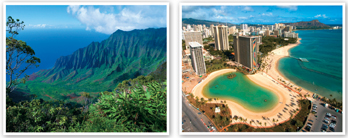6.1 A Changing Landscape
 How do our daily activities affect the environment?
How do our daily activities affect the environment? What is the relationship between resource use and sustainable development?
What is the relationship between resource use and sustainable development?
monoculture
renewable resource
nonrenewable resource
sustainable development
Outline As you read, create an outline using the green and blue heads in this lesson. As you read, fill in key words, phrases, and ideas about each heading.
THINK ABOUT IT The first humans to settle Hawaii came from Polynesia about 1600 years ago. These island people had customs that protected the natural resources of their new home. For example, they were prohibited from catching certain fish during spawning season and, for every coconut palm tree cut down, they had to plant two palms in its place. But Hawaiians did not treat their islands entirely like nature reserves. They cut trees to plant farms, and they introduced nonnative plants, pigs, chickens, dogs, and rats. This combination drove many native plant and animal species to extinction. Yet for centuries Hawaii's ecosystems provided enough fresh water, fertile soil, fish, and other resources to keep the society self-sufficient. What happened next is a lesson on managing limited resources—a lesson that is as important today as it was over 1000 years ago.
The Effect of Human Activity
 How do our daily activities affect the environment?
How do our daily activities affect the environment?
Beginning in the late 1700s, new waves of settlers arrived in Hawaii. These people did not seem to understand the limits of island ecosystems. They imported dozens more plants and animals that became invasive pests. They cleared vast tracts of forest to grow sugar cane, pineapples, and other crops that required lots of water. And as the island's human population grew, they converted untouched land for other uses, including housing and tourism, as shown in Figure 6–1. The effect of these activities on Hawaii's ecosystems and its human inhabitants offers a window onto a globally important question: What happens when a growing human population does not adequately manage natural resources that are both vital and limited?
MYSTERY CLUE

Easter Island's first colonists brought with them banana trees, taro root, and chickens—and possibly some small mammalian “stowaways.” What impact might these new organisms have had on the island's ecosystems?

FIGURE 6–1 The Lesson of Hawaii Kalalau Valley along the Na Pali coast of Kauai looks almost untouched by humans. In contrast, Waikiki Beach on the island of Oahu is surrounded by built-up areas that support tourism.
d
Table of Contents
- Formulas and Equations
- Applying Formulas and Equations
- Mean, Median, and Mode
- Estimation
- Using Measurements in Calculations
- Effects of Measurement Errors
- Accuracy
- Precision
- Comparing Accuracy and Precision
- Significant Figures
- Calculating With Significant Figures
- Scientific Notation
- Calculating With Scientific Notation
- Dimensional Analysis
- Applying Dimensional Analysis




